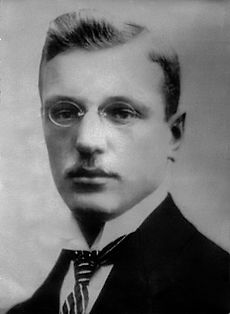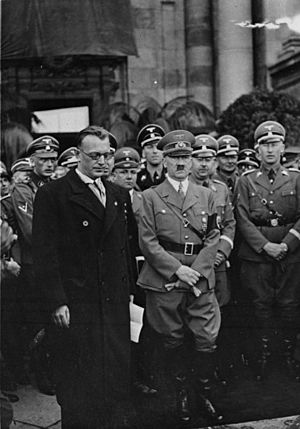Arthur Seyss-Inquart facts for kids
Quick facts for kids
Arthur Seyss-Inquart
|
|
|---|---|
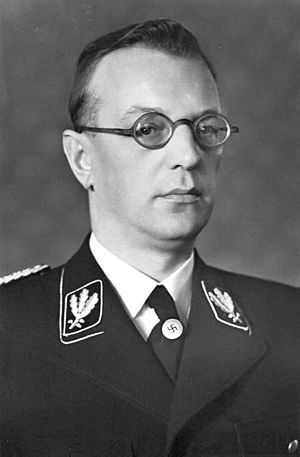
Inquart c. 1940s
|
|
| Chancellor of Austria | |
| In office 11 March 1938 – 13 March 1938 |
|
| President | Wilhelm Miklas |
| Vice-Chancellor | Edmund Glaise-Horstenau |
| Preceded by | Kurt Schuschnigg |
| Succeeded by | Karl Renner (1945) |
| Reichsminister of Foreign Affairs | |
| In office 30 April 1945 – 2 May 1945 |
|
| Chancellor | Joseph Goebbels |
| Preceded by | Joachim von Ribbentrop |
| Succeeded by | Lutz Schwerin von Krosigk |
| Reichskommissar of the Netherlands | |
| In office 29 May 1940 – 7 May 1945 |
|
| Preceded by | Alexander von Falkenhausen (Military Governor) |
| Succeeded by | Office abolished |
| Deputy Governor-General of the General Government of Occupied Poland |
|
| In office 12 October 1939 – 18 May 1940 |
|
| Governor-General | Hans Frank |
| Preceded by | Office established |
| Succeeded by | Josef Bühler |
| Reichsminister without portfolio | |
| In office 1 May 1939 – 30 April 1945 |
|
| Chancellor | Adolf Hitler |
| Reichsstatthalter of Austria | |
| In office 15 March 1938 – 1 May 1939 |
|
| Preceded by | Office established |
| Succeeded by | Josef Bürckel |
| Minister of Defence of Austria | |
| In office 11 March 1938 – 13 March 1938 |
|
| Preceded by | Kurt Schuschnigg |
| Succeeded by | Ferdinand Graf (1945) |
| Minister of the Interior of Austria | |
| In office 16 February 1938 – 13 March 1938 |
|
| Preceded by | Edmund Glaise-Horstenau |
| Succeeded by | Franz Honner (1945) |
| Personal details | |
| Born | 22 July 1892 Stannern, Margraviate of Moravia, Austria-Hungary (now Stonařov, Vysočina Region, Czech Republic) |
| Died | 16 October 1946 (aged 54) Nuremberg Prison, Nuremberg, Allied-occupied Germany |
| Cause of death | Execution by hanging |
| Political party |
|
| Spouse |
Gertrud Maschka
(m. 1916) |
| Children | 3 |
| Cabinet | Seyss-Inquart |
| Military service | |
| Allegiance | |
| Branch/service | |
| Years of service | 1914–1918 |
| Battles/wars | World War I |
| Criminal conviction | |
| Criminal status | Executed |
| Conviction(s) | Crimes of aggression War crimes Crimes against humanity |
| Trial | Nuremberg trials |
| Criminal penalty | Death |
Arthur Seyss-Inquart (born July 22, 1892 – died October 16, 1946) was an Austrian politician. He briefly served as the Chancellor of Austria in 1938, just before Austria became part of Nazi Germany. He also held important roles in Nazi Germany, including a high position in German-occupied Netherlands.
During World War I, Seyss-Inquart fought bravely for the Austro-Hungarian Army. After the war, he became a successful lawyer. He later joined the governments of Austrian Chancellors Engelbert Dollfuss and Kurt Schuschnigg. In 1938, when Germany planned to invade Austria, Schuschnigg resigned. Seyss-Inquart then became the new Chancellor. The new government quickly transferred power to Germany. Austria then became a German province called Ostmark, with Seyss-Inquart as its governor.
During World War II, Seyss-Inquart was a deputy governor in occupied Poland. In 1940, after Germany took over the Low Countries, he became the Reichskommissar (a high-ranking official) for the occupied Netherlands. He was a member of the Schutzstaffel (SS), a powerful Nazi organization. During his time in the Netherlands, many Dutch civilians were forced to work for Germany. Many Dutch Jewish people were also sent away from their homes.
After the war, Seyss-Inquart was put on trial at the Nuremberg Trials. He was found responsible for serious actions during the war. He was sentenced to death and executed.
Contents
Early Life and Education
Arthur Seyss-Inquart was born in 1892 in a village called Stannern. This village was in an area where German and Czech people lived. His father was Czech and his mother was German. The family moved to Vienna in 1907.
Seyss-Inquart later studied law at the University of Vienna. In August 1914, at the start of World War I, he joined the Austro-Hungarian Army. He fought in different areas, including Russia and Italy. He received awards for his bravery. While recovering from injuries in 1917, he finished his law degree.
In 1911, Seyss-Inquart met Gertrud Maschka. They got married in December 1916 and had three children.
Political Career and Austria's Annexation
After the war, Seyss-Inquart became a lawyer and started his own practice in 1921. He was a successful lawyer and was asked to join the government of Chancellor Engelbert Dollfuss in 1933. After Dollfuss was killed in 1934, Seyss-Inquart became a State Councillor under Kurt Schuschnigg in 1937.
He was interested in mountain climbing and led the German-Austrian Alpine Club. He also became interested in some of the ideas of Heinrich Himmler, a key Nazi leader. Seyss-Inquart was not a member of the Austrian Nazi party at first. However, he agreed with many of their ideas. By 1938, he became a public supporter of the Austrian Nazis.
In February 1938, Adolf Hitler threatened Austria with military action. Because of this, Schuschnigg appointed Seyss-Inquart as Austria's Minister of the Interior. On March 11, 1938, Schuschnigg resigned as Chancellor. This was because Germany was planning to invade Austria. Under pressure from Germany, President Wilhelm Miklas appointed Seyss-Inquart as the new Chancellor.
The next day, German troops entered Austria. This was done after Seyss-Inquart sent a telegram inviting them. This telegram was prepared beforehand to make the invasion seem justified. Hitler had initially planned for Austria to be a Nazi-friendly state led by Seyss-Inquart. However, many Austrians welcomed the German army. This led Hitler to decide on a full Anschluss, which meant Austria was fully taken over by Nazi Germany. On March 13, 1938, Seyss-Inquart officially joined the Nazi Party.
Governor of Ostmark and Role in Poland
Seyss-Inquart helped create the law that made Austria a province of Germany. He signed this law on March 13. With Hitler's approval, he became the Governor (Reichsstatthalter) of the new province, called Ostmark. This made him Hitler's personal representative in Austria. Soon after taking office, he ordered the seizure of Jewish property. He also helped send Jewish people from Austria to camps.
After Germany invaded Poland, Seyss-Inquart was briefly named Chief of Civil Administration for Southern Poland. He then became the Deputy to the Governor General Hans Frank in the General Government. He supported the harsh policies in Poland, including actions against Jewish people. He also knew about the killing of Polish intellectuals.
Reichskommissar in the Netherlands
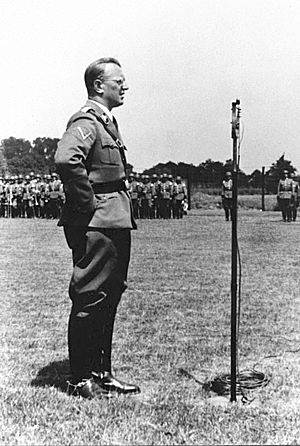
After the Low Countries surrendered, Seyss-Inquart was appointed Reichskommissar for the Occupied Netherlands in May 1940. His job was to manage the government, create economic ties with Germany, and protect Germany's interests. In April 1941, he was promoted in the SS. Dutch people sometimes called him "Zes en een kwart" (six and a quarter). This was a play on his name and the fact that he had a limp.
He supported the Dutch Nazi party and allowed them to form a group that helped the police. Other political parties were banned in late 1941. Many former government officials were put in prison. Seyss-Inquart controlled the country's administration and reported directly to Hitler. He also set up many groups that promoted Nazi ideas.
He introduced rules to stop resistance. When there was a large strike in May 1943, special court procedures were used. A large fine was also imposed. Seyss-Inquart approved about 800 executions before the country was freed. Some reports say the total was over 1,500. These included executions of political prisoners and revenge killings.
There were three main camps in the Netherlands: KZ Herzogenbusch, Kamp Amersfoort, and Westerbork transit camp. Many other camps were controlled by the military or police. In total, about 530,000 Dutch civilians were forced to work for the Germans. About 250,000 of them were sent to factories in Germany.
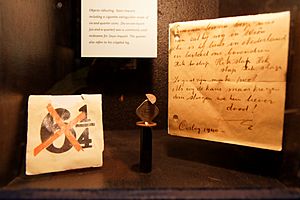
Seyss-Inquart was strongly against Jewish people. Within months of arriving in the Netherlands, he took steps to remove Jewish people from government, media, and important jobs. Actions against Jewish people became more severe after 1941. About 140,000 Jewish people were registered. A "ghetto" was created in Amsterdam, and a transit camp was set up at Westerbork.
Later, Dutch Jewish people were sent to Buchenwald and Mauthausen camps. Many were also sent to Auschwitz, a very well-known camp in Poland. As Allied forces got closer in September 1944, the remaining Jewish people at Westerbork were moved to Theresienstadt. Out of the 140,000 registered, only 30,000 Dutch Jewish people survived the war.
When the Allies moved into the Netherlands in late 1944, the Nazi government tried to destroy docks and harbors. However, Seyss-Inquart agreed with Armaments Minister Albert Speer that these actions were pointless. They greatly limited the destruction.
At the end of the Dutch "hunger winter" in April 1945, Seyss-Inquart was convinced by the Allies to allow planes to drop food for the starving Dutch civilians. Even though he knew the war was lost, Seyss-Inquart did not want to surrender.
Before Hitler died in April 1945, he named a new government. In this government, Seyss-Inquart became the Foreign Minister. This showed how much Hitler respected him. However, at this late stage of the war, Seyss-Inquart could not achieve anything in his new role.
He stayed in his positions until May 7, 1945. He was arrested on the Elbe Bridge in Hamburg by two soldiers. One of them was Norman Miller, a German Jewish man who had escaped to Britain before the war.
Nuremberg Trials
At the Nuremberg Trials, Seyss-Inquart was put on trial. He faced charges related to planning aggressive wars and actions against people during the war. During the trial, an American psychologist tested the Nazi leaders. Arthur Seyss-Inquart scored 141 on an IQ test, which was the second highest among the defendants.
In his final statement, Seyss-Inquart said he did not know about some of the actions, like the shooting of hostages. He said he had moral concerns about sending Jewish people away. However, he believed there could be reasons for large-scale movements of people. He also mentioned that the Allies moved millions of Germans after the war. He stated that his "conscience was untroubled" because he believed he improved conditions for the Dutch people. Seyss-Inquart ended by saying, "I believe in Germany."
Seyss-Inquart was found responsible for his actions during the war. He was sentenced to death. The court's decision highlighted his role in suppressing opponents and the actions against Jewish people, especially in the Netherlands. These actions led to his sentence.
When he heard his sentence, Seyss-Inquart accepted it. He said, "Death by hanging... well, in view of the whole situation, I never expected anything different. It's all right."
Before his execution, Seyss-Inquart returned to the Catholic church. He was hanged in Nuremberg Prison on October 16, 1946, at the age of 54. He was hanged with nine other defendants. He was the last one to be executed. His last words were: "I hope that this execution is the last act of the tragedy of the Second World War and that the lesson taken from this world war will be that peace and understanding should exist between peoples. I believe in Germany."
His body was cremated, and his ashes were scattered into the river Isar.
See Also
 In Spanish: Arthur Seyß-Inquart para niños
In Spanish: Arthur Seyß-Inquart para niños
- List of SS-Obergruppenführer
- Nazi plunder
- The Holocaust in the Netherlands
- Kajetan Mühlmann
- Anschluss


